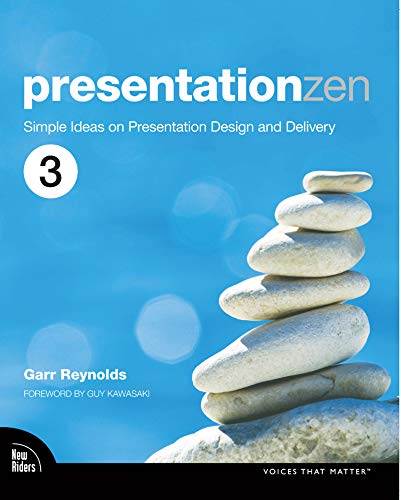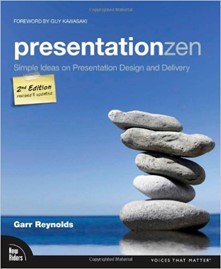Presentation Zen: Simple Ideas on Presentation Design and Delivery

I’m no stranger to presentations. I’ve averaged over 50 presentations a year for several years now. So on average every week I’m getting in front of a crowd with the privilege of sharing my experience. As a natural consequence of so much presenting you’ll learn a thing or two about the art of connecting with your audience. However, I’m always looking to improve my craft. Years ago I was getting trained for standup comedy and improvisation. (See I am a comedian.) With the recent changes to the video studio, I wanted to find a new look for my branded presentations. I needed something that would accommodate me being overlaid on the slides and something that looked good on the TV on the set. That led me to a set of conversations with experienced presenters and designers – with a lot of conflicting advice. Anytime that I get conflicting advice, I realize it’s time to do research. I started with Presentation Zen: Simple Ideas on Presentation Design and Delivery. Along the way I didn’t find the answer to what to do about design of my slides – but I did find that there some answers that I already knew.

Following, Detaching, and Fluent
There were time honored ways of teaching before Gutenberg created the movable type printing press and suddenly made explicit knowledge much easier to transfer. There was a time when the best way to learn something was to work with a master in a craft until you mastered the craft and could lead your own shop. For centuries we studied in the familiar apprentice, journeyman, and master model. We’ve largely abandoned this model of teaching and learning. Instead we focused on “book learning” where we value the ability to recall what was covered in a written form. Despite Bloom et al.’s Taxonomy of Educational Objectives, little of the way that we teach today is focused on doing. There are the occasional pockets of educators trying experiential learning, however, the staple of the educational system today is lecture and reading.
However, we’ve lost the simplicity of apprentice, journeyman, and master. From the perspective of the action, this is following, detaching, and fluent. The apprentice is following the instructions of a master or a journeyman. They do only what they’re told and only when they’re told. They’re learning the mechanics of the craft. Journeymen have the basic skills mastered and know what the rules are they need to follow. They’re being directed by a master but are competent enough to work autonomously most of the time. Obviously the masters are folks who can direct the work of others but more than this masters understand the principles on which the rules are formed. They’re not focused on the mechanics of their craft. They’re focused on the art of the craft.
Presentation Zen quotes Zen scholar Daisetz T. Suzuki saying “The first principle of art is not to rely on tricks of technique.” To me this passage was a clear focus on how you have to learn more than just masterful practice of a single skill. I recently was invited to a Toastmaster’s meeting and I was impressed at the precision with which the group was run. The structure and the guides clearly worked for providing the basic scaffolding that is necessary. More than that the scaffolding reinforced practice – which is necessary. At the same time I saw a reliance on the rules that made me wonder if techniques were the key to good presentations. I can tell you that in my experience that isn’t the case.
Making a Connection
One of the things that is too often overlooked in presentations is the connection between the audience and the presenter. Too often the relationship that exists between the presenter and the audience – no matter how brief – is ignored. I know from my experience that folks who have been in my audiences have approached me years later to tell me how they enjoyed my sessions. Most of the feedback that I get now is that my sessions are the most interactive experiences that listeners are in – that’s no accident. I make a point to make my sessions interactive.
In presentations it’s the slides that get the best supporting actor role. They’re there to make it easier for the listener to connect with the presenter and the content. Good slides help to build the connection to the presenter – they don’t usurp the presenter. We’ve all seen presentations where the presenter could literally disappear off stage. We could read the slides and get just as much meaning as with the presenter there. This is a very sad state of affairs.
Good presentation cannot replace the presenter. They shouldn’t be delivered to attendees to review while the presenter is on the stage (See Efficiency in Learning for split attention.) Slides shouldn’t be able to carry the entire message after the event. If learning is the goal – rather than inspiring – then a separate set of educational materials should be produced and delivered.
Signal to Noise Ratio
Michelangelo was to say that to form his classic David sculpture that all he had to do was remove what was covering it. He said that the beauty was there all along. He didn’t create it, he uncovered it. Such is true in the development of our presentation materials. We must remove all of the distractions and coverings which prevent our listeners from hearing our central message.
In communications this is called a signal-to-noise ratio. The greater this ratio the better the reception. Our goal is to get as much signal-to-noise ratio as possible and that means ruthlessly removing anything that doesn’t contribute to the message. It’s an exercise in “less is more.” We can amplify the signal by reinforcing it with visuals – but we run the risk of creating distraction and noise. Many authors have been quoted with variations on the theme that “I would have written a shorter letter if I only had more time.” That is that refining to the core central message is harder than simply writing whatever comes to mind. It takes effort to decide which topics that have been painstakingly researched and considered just can’t be a part of the final presentation.
The Silence of the Mind – Solitude
When I’m speaking to audiences about knowledge management I frequently show a progression from data through information to knowledge and ultimately to wisdom. I move from symbols to insight. This progression represents the comfort and peace that someone has developed with the external stimulus in their worlds. That peace doesn’t come from constantly running and striving to get to the next thing. The peace is a side effect of time to reflect and consider. Presentation Zen shared the Taoist proverb “We cannot see our reflection in running water. It is only in still water that we can see.” In order to raise our presentations from the mere regurgitation of data to a way to help others make sense of that data we have to have the time necessary to pause and reflect.


While the silence can be literal silence in the place that we’re in, more often it’s quieting our mind so that we can focus on one thing or set of things. I’ve been able to find a silence in my mind to ponder things in the middle of extremely noisy environments. Some of that I accomplished by putting earbuds in and listening to music that could drown out the external noises but more than that, I could make a decision to focus on one thing for a while.
Presentation Jazz
One of the things that I know about presentations is that my best presentations are like good Jazz. That’s where the audience and I are in sync and we’re producing an experience together that we all were a part of. I’ve often ended completely off my presentation “script” (which is really just a rough plan). We’ve talked about topics that I had no intention of discussing but it worked well. Jazz musicians in addition to knowing when to not play are good at developing that connection with the other musicians and “getting into a groove.”
Once I was running audio for a church performance with a rock band. I distinctly remember the moment that the band really locked on to one another and started playing together. It was an amazing difference that from a technical perspective was probably imperceptible. Everything just started to line up. That’s what a good presentation is. All of the elements – the delivery, the supporting materials, and the audience – being in perfect harmony for just a moment.
I may not have the answer to how to create the best presentation materials – but I did rediscover my own Presentation Zen.
